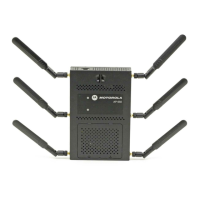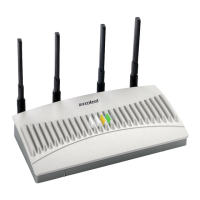Wireless Configuration
6-39
3. Set the following Video Access settings for the WLAN’s QoS policy:
4. Set the following Voice Access settings for the WLAN’s QoS policy:
Multicast Mask
Secondary
Set a secondary multicast mask for the WLAN QoS policy.
Multicast Mask
Classification
Select a drop-down menu option to determine the priority at which
immediate multicast/broadcast packets go out. This setting overwrites the
WLAN Client Classification. This does not affect multicast/broadcast
packets going out at DTIM. The default setting (Normal) mean immediate
multicast/broadcast packets go out at the classification priority. For
WMM, this means Best Effort.
Transmit Ops Use the slider to set the maximum duration a device can transmit after
obtaining a transmit opportunity. The default values is 94.
AIFSN Set the current Arbitrary Inter-frame Space Number (AIFSN) between 2-15.
Higher-priority traffic video categories should have lower AIFSNs than
lower-priority traffic categories. This will cause lower-priority traffic to
wait longer before attempting access. The default value is 2.
ECW Min The ECW Min is combined with the ECW Max to create the contention
value in the form of a numerical range. From this range, a random number
is selected for the back off mechanism. Lower values are used for higher
priority traffic (like video). The available range is from 0-15. The default
value is 3.
ECW Max The ECW Max is combined with the ECW Min to create the contention
value in the form of a numerical range. From this range, a random number
is selected for the back off mechanism. Lower values are used for higher
priority traffic (like video). The available range is from 0-15. The default
value is 4.
Transmit Ops Use the slider to set the maximum duration a device can transmit after
obtaining a transmit opportunity. The default value is 47.
AIFSN Set the current Arbitrary Inter-frame Space Number (AIFSN) between 2-15.
Higher-priority traffic voice categories should have lower AIFSNs than
lower-priority traffic categories. This will cause lower-priority traffic to
wait longer before attempting access. The default value is 2.
ECW Min The ECW Min is combined with the ECW Max to create the contention
value in the form of a numerical range. From this range, a random number
is selected for the back off mechanism. Lower values are used for higher
priority traffic. The available range is from 0-15. The default value is 2.
ECW Max The ECW Max is combined with the ECW Min to create the contention
value in the form of a numerical range. From this range, a random number
is selected for the back off mechanism. Lower values are used for higher
priority traffic. The available range is from 0-15. The default value is 3.

